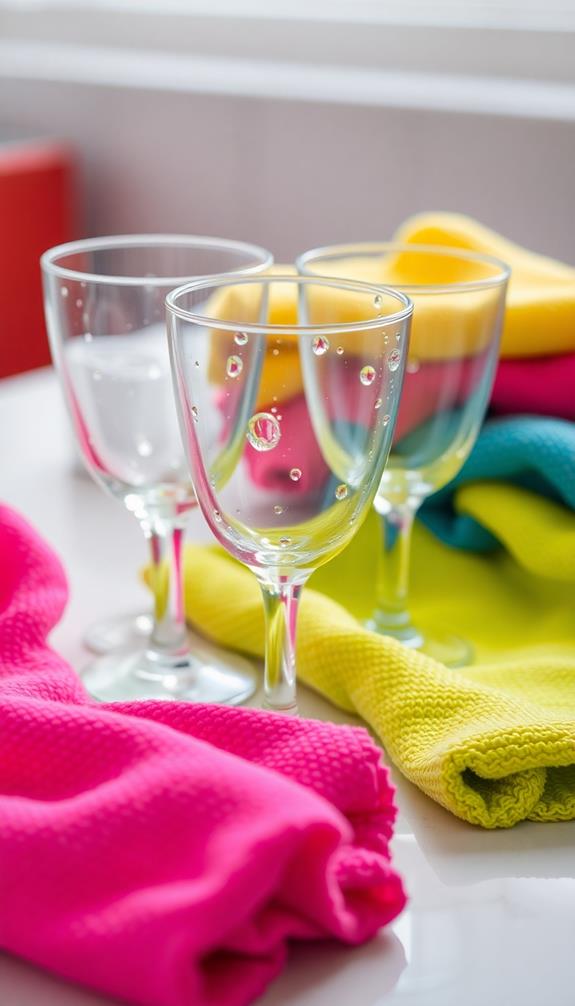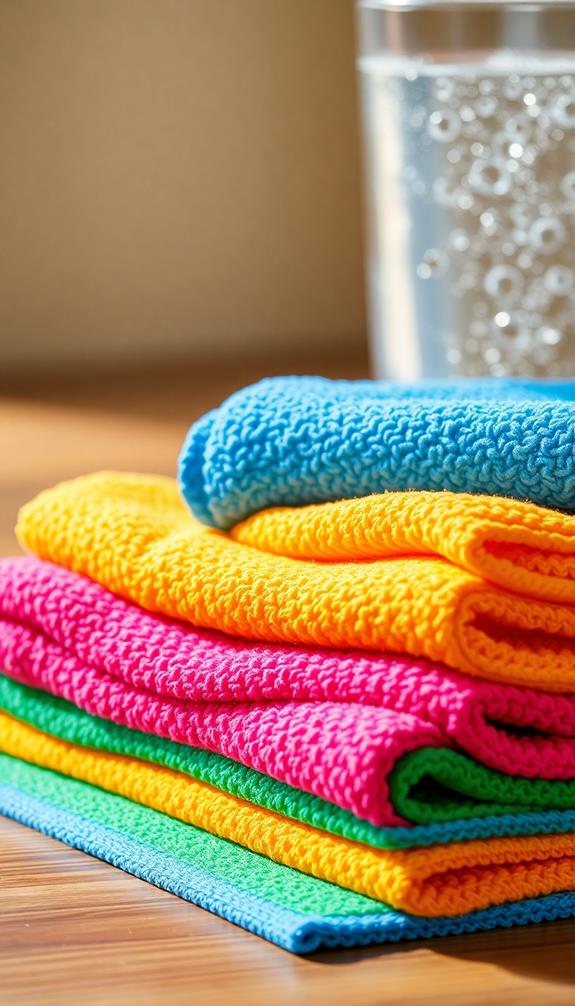To wash your microfiber cloths for crystal clear glasses, start with a gentle cycle in warm water using a bleach-free detergent. Avoid fabric softeners, as they can damage the microfiber's effectiveness. Wash your cloths separately to prevent lint transfer from other fabrics. After washing, air dry or tumble dry on low heat—make sure they're completely dry before using them again. Regularly cleaning your cloths protects against dust and oils that can cause smudges. For tips on enhancing your cleaning routine and prolonging the life of your cloths, keep exploring further.
Importance of Clean Microfiber Cloths
Understanding the importance of clean microfiber cloths is vital for maintaining the clarity of your lenses. Dirty cloths can transfer dust and oils back onto your glasses, leading to smudges and decreased visibility. That's why regularly washing microfiber cloths is essential.
It helps restore their fiber gaps, which enhances their ability to attract and trap dirt, thereby improving overall cleaning performance. By using non-toxic cleaning solutions for your microfiber cloths, you guarantee that harmful chemicals don't compromise the integrity of your lenses.
By maintaining clean microfiber cloths, you not only guarantee superior cleaning but also prolong their lifespan, allowing for repeated use without compromising effectiveness. This is especially important for preserving the integrity of delicate lens surfaces.
Using unclean cloths can lead to scratches on your lenses, as accumulated debris can act abrasively. Eye care professionals often recommend washing these cloths every few weeks to mitigate the risks associated with contaminated cloths.
Incorporating these practices into your lens care routine will help you enjoy a clear, unobstructed view, guaranteeing that your glasses remain in prime condition.
Effective Cleaning Methods
When it comes to cleaning microfiber cloths, you have a few effective methods at your disposal.
Utilizing natural cleaning agents can enhance the cleaning process, ensuring that your cloths remain free from grime and bacteria.
Whether you choose to hand wash or machine wash, it's essential to follow specific guidelines to keep the cloths in top shape.
Don't forget about proper drying and storage to maintain their cleaning power for the long haul.
Hand Washing Techniques
Microfiber cloths deserve careful handling to maintain their cleaning power, and hand washing is an effective method to achieve that.
Start by washing your hands with lotion-free soap to avoid transferring oils or residues to the microfiber cloth. Next, rinse the cloth under cold water to remove any loose dirt and debris before applying soap.
Use a mild, bleach-free soap for gentle cleaning. Rub the cloth between your fingers to create a lather, but be careful not to scrub too hard, as this can damage the fibers.
After washing, rinse the cloth thoroughly under cold running water to guarantee all soap is removed. Remember, any leftover soap residue can diminish the cloth's effectiveness.
Once cleaned, it's vital to air dry the microfiber cloth completely. Lay it flat or hang it up; avoid tumble drying, as high heat can harm the fibers.
Machine Washing Guidelines
For effective cleaning while preserving their fiber integrity, use a washing machine with a gentle cycle and warm water for your microfiber cloths. This method guarantees that the fibers remain intact, enhancing their longevity and cleaning effectiveness.
When selecting a detergent, make certain it's bleach-free, as harsh chemicals can degrade the fibers over time, reducing their ability to trap dirt and oils.
Avoid using fabric softeners, since they create a residue that can hinder the cloths' performance. It's also essential to wash microfiber cloths separately from cotton or other materials to prevent lint transfer, which can compromise their cleaning capabilities.
Once the washing cycle is complete, you have two options: air dry or tumble dry on low heat. Tumble drying helps maintain the cloths' shape, while air drying is a gentler method that also preserves their integrity.
Whichever method you choose, make certain your microfiber cloths are completely dry before using them again. By following these machine washing guidelines, you'll keep your microfiber cloths in top shape for crystal clear glasses and superior cleaning results.
Drying and Storage Tips
After washing your microfiber cloths, the way you dry and store them plays a significant role in maintaining their cleaning power. Air drying is your best bet, as it preserves the integrity of the micro-fiber material, ensuring peak cleaning performance. If you choose to use a dryer, stick to a low heat setting to avoid damaging the fibers, which can happen with high temperatures.
When it comes to storage, always store microfiber cloths in a clean, dry place. Ideally, use small bags or containers to protect them from dust and contamination when not in use.
If you have larger cloths, consider cutting them into smaller pieces for enhanced portability and hygiene, just make sure each piece is stored properly.
Don't forget to regularly inspect stored microfiber cloths for any signs of wear or contamination. If any appear excessively worn or dirty, replace them to maintain their effectiveness.
Benefits of Regular Washing

Regularly washing your microfiber cloths offers several significant benefits that enhance their cleaning performance. By keeping your cloths clean, you guarantee that they effectively trap dirt and oils, leading to crystal-clear eyeglasses every time.
Additionally, using microfiber cloths for efficient cleaning can further improve the overall results you achieve with your cleaning tasks.
Here are three key benefits of regular washing:
- Improved Cleaning Performance: Clean cloths restore their fiber gaps, allowing them to attract and hold dirt and oils more effectively. This results in better cleaning outcomes for your lenses.
- Prevent Accumulation: Frequent washing helps eliminate contaminants like oils and dust that can accumulate over time. This prevents smudges and scratches on your eyeglasses, preserving lens clarity and overall quality.
- Prolong Lifespan: Microfiber cloths are durable and can withstand multiple washings. Regular maintenance not only keeps them clean but also prolongs their lifespan, reducing the need for replacements.
Incorporating these practices into your routine guarantees that you maintain high-quality cleaning tools.
With clean microfiber cloths, you'll enjoy improved lens clarity and visual comfort, making your cleaning process more effective and efficient.
Storage and Maintenance Tips
Storing and maintaining your microfiber cloths properly is essential for guaranteeing their longevity and cleaning effectiveness. Start by keeping them in a clean, dry environment. Small bags or film canisters work well to prevent contamination and maintain hygiene.
When you use the cloth, make sure to only touch one designated side. This practice minimizes dirt transfer, keeping the other side clean for effective cleaning. Additionally, consider using high-quality cleaning tools to enhance your overall cleaning experience.
Regularly assess the condition of your microfiber cloths. If they become excessively worn or stained, it's time to replace them to maintain peak cleaning performance. Prolonged exposure to direct sunlight can degrade the material, so avoid leaving them in bright light.
Additionally, keep new microfiber cloths sealed in their packaging until you're ready to use them. This way, you guarantee they remain free of debris before they touch your precious lenses.
Choosing Quality Microfiber Cloths

When selecting quality microfiber cloths, it's important to focus on key features that enhance their performance. High-quality microfiber cloths can make a significant difference when it comes to cleaning your glasses effectively and achieving a streak-free finish.
Additionally, using proper cleaning techniques can further improve the results, such as avoiding harsh chemicals to maintain the integrity of the fibers gentle cleaners for upholstery.
Here are three essential aspects to take into account:
- High GSM: Look for microfiber cloths with a high GSM (grams per square meter) rating. This indicates better absorbency and cleaning capability, which is critical for removing smudges and dirt.
- Extra-fine fibers and seamless edges: Choose cloths made from extra-fine fibers that can easily reach into crevices. Seamless edges are also significant to minimize the risk of scratching your lenses.
- Anti-static properties: Opt for microfiber cloths with anti-static properties. This helps reduce dust attraction, keeping your glasses cleaner for longer.
Risks of Improper Cleaning
Improperly cleaning your microfiber cloths can lead to serious consequences for your lenses. If you use contaminated or dirty microfiber, you risk scratching your lenses, which can result in permanent damage and reduced optical clarity.
Regular cleaning is essential; failing to wash your microfiber cloths often allows dirt and oils to accumulate, leading to streaks and ineffective cleaning. Utilizing proper cleaning techniques for your cleaning tools, such as effective cleaning methods, guarantees peak performance and maintains the integrity of your lenses.
Using improper cleaning agents, like harsh soaps or household cleaners, can also damage lens coatings, compromising their protective qualities. Always choose a detergent specially made for microfiber to avoid this issue.
In addition, neglecting the condition of your microfiber cloths can diminish their effectiveness. Fraying or heavy staining can transfer debris to your lenses, causing scratches.
Conclusion
So, if you think tossing your microfiber cloths into the wash with your gym socks is a genius idea, you might want to rethink that strategy. After all, crystal clear glasses deserve more than a laundry room toss-up. Treat those cloths like the delicate divas they are, and watch your glassware shine like it's been kissed by the sun. Remember, a clean cloth is a happy cloth—and a happy cloth makes for happy glasses. Cheers to clarity!